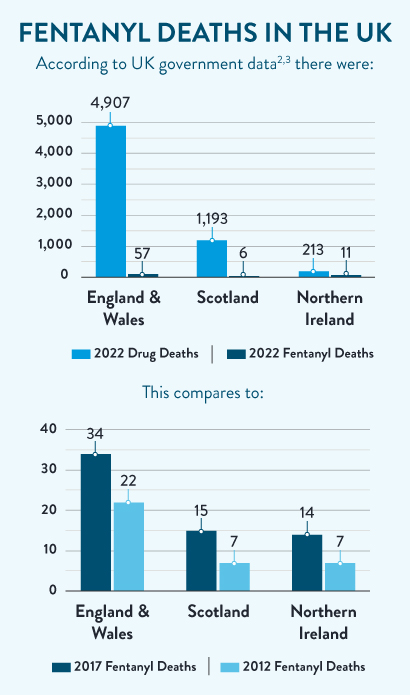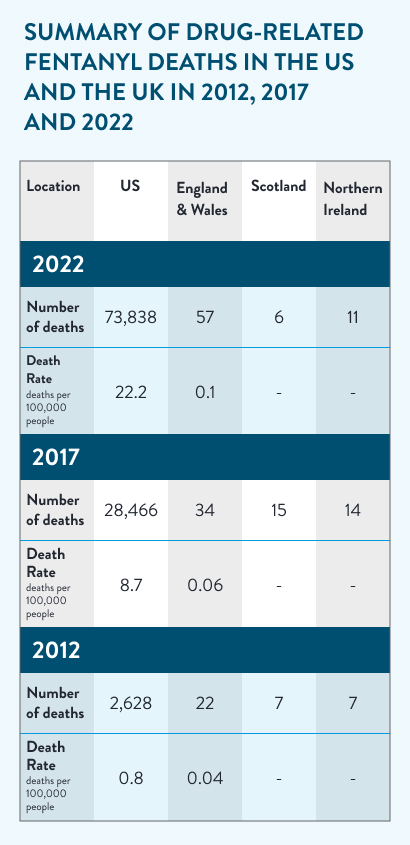TOXICOLOGY

Recent reports have highlighted the rise in deaths caused by the opioid drug fentanyl across the United States. In 2022, out of 107,941 drug-related deaths, 73,838 people died from an overdose involving fentanyl. This is a staggering average of 202 people each day of the year. Over five years, fentanyl deaths increased by 159% from 28,466 in 2017. Over 10 years, fentanyl-related deaths surged by 2709% from 2,628 fentanyl deaths in 2012.1


In 2022, the US had 22.2 fentanyl deaths per 100,0001,2 people, while England and Wales had 0.1 fentanyl deaths per 100,000 people. The fentanyl death rate in the US is 222 times higher than in England and Wales. While US fentanyl-related deaths continue to rise, fentanyl deaths in England and Wales peaked in 2017 with 75 deaths; in Scotland, they peaked in 2019 with 25 deaths; and in Northern Ireland, they peaked in 2015 with 15 deaths.


There has been an increase in annual drug deaths in the US of 66,439 (160%) since 2012. This rise has almost exclusively been driven by the increase in deaths caused by fentanyl. Fentanyl deaths in this period have increased by 71,210. Over the same period, England and Wales have seen an increase of 2,310 (89%) deaths, with fentanyl contributing 35 deaths to this total. The increase in England and Wales is due to a range of substances, rather than one single drug.
Fentanyl is included in our VerumTM Drug Panel which targets drugs and metabolites including stimulants, opiates/opioids, cannabinoids, gabapentinoids, sedatives and antidepressants in oral fluid. Most commonly used to analyse samples from drug treatment clinics, it provides a comprehensive overview of prevalence data across the UK. 22,328 oral fluid samples were tested for fentanyl over the period from March 2019 to August 2022.5 Fentanyl was only detected in 8 of these samples, resulting in a positivity rate of 0.036%.5
A comparison of fentanyl-related deaths between the US and the UK suggests that the fentanyl crisis in the US is not mirrored in the UK. Data from drug testing in a drug treatment population, further indicates that fentanyl use is low in the United Kingdom.
A Leader in Toxicology
©2025 Abbott. All rights reserved. Unless otherwise specified, all product and service names appearing in this Internet site are trademarks owned by or licensed to Abbott, its subsidiaries or affiliates. No use of any Abbott trademark, trade name, or trade dress in this site may be made without the prior written authorization of Abbott, except to identify the product or services of the company.
This website is governed by applicable U.S. laws and governmental regulations. The products and information contained herewith may not be accessible in all countries, and Abbott takes no responsibility for such information which may not comply with local country legal process, regulation, registration and usage.
Your use of this website and the information contained herein is subject to our Website Terms and Conditions, Privacy, and Cookie Policy.
Abbott - A Global Leader in Toxicology.